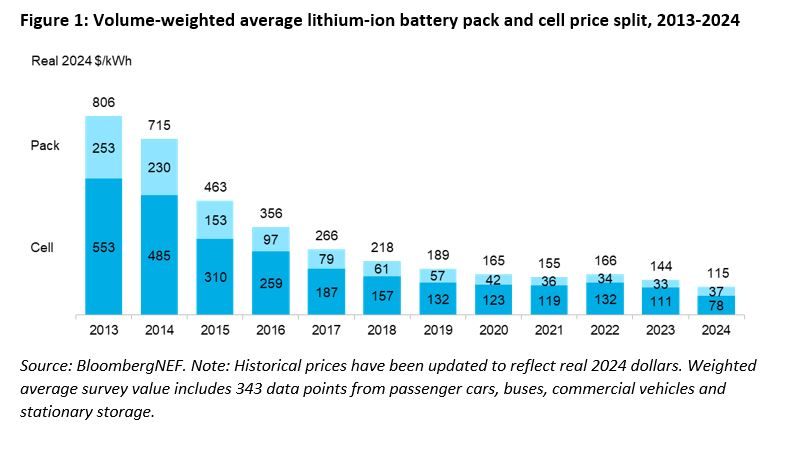Supply chain
BNEF: Lithium-ion battery pack prices drop to record low of $115/kWh
Battery prices continue to tumble on the back of lower metal costs and increased scale, squeezing margins for manufacturers. Further price declines are expected over the next decade.

By
Marija Maisch
Dec 11, 2024
Industry
Manufacturing
Supply chain

Image: BNEF
Battery prices saw their biggest annual drop since 2017, with lithium-ion battery pack prices down by 20% from 2023 to a record low of $115/kWh, according to analysis by BloombergNEF (BNEF).
Factors driving the decline include cell manufacturing overcapacity, economies of scale, low metal and component prices, adoption of lower-cost lithium-iron-phosphate (LFP) batteries, and a slowdown in electric vehicle sales growth.
Currently, overcapacity is rife, with 3.1 TWh of fully commissioned battery-cell manufacturing capacity globally. That is more than 2.5 times annual demand for lithium-ion batteries in 2024, according to BNEF.
“The price drop for battery cells this year was greater compared with that seen in battery metal prices, indicating that margins for battery manufacturers are being squeezed. Smaller manufacturers face particular pressure to lower cell prices to fight for market share,” said Evelina Stoikou, the head of BNEF’s battery technology team and lead author of the report.
The figures represent an average across different geographies and multiple application areas, including different types of electric vehicles, buses and stationary storage projects.
On a regional basis, average battery pack prices were lowest in China, at $94/kWh. Packs in the US and Europe were 31% and 48% higher, reflecting the relative immaturity of these markets, as well as higher production costs and lower volumes, BNEF finds.
The price differences for North America and Europe compared to China were higher than in other years. THis indicates that the drop in prices was more accentuated in China forcing many battery manufacturers to enter new markets, including energy storage, while also eyeing overseas markets willing to pay more for batteries.
Meanwhile, prices for battery electric vehicles (BEVs) came in at $97/kWh, crossing below the $100/kWh threshold for the first time. While EVs have reached price parity in China, they are still more expensive than comparable combustion cars in many markets but this is expected to change in the years ahead.
The industry has also benefitted from low raw material prices. BNEF expects metal prices to rise in the next few years, as geopolitical tensions, tariffs and low prices stall new mining and refining projects.
“One thing we’re watching is how new tariffs on finished battery products may lead to distortionary pricing dynamics and slow end-product demand. Regardless, higher adoption of LFP chemistries, continued market competition, improvements in technology, material processing and manufacturing will exert downward pressure on battery prices,” said Yayoi Sekine, head of energy storage at BNEF.
BNEF expects pack prices to decrease by $3/kWh in 2025, based on its near-term outlook. Looking ahead, further price drops are expected over the next decade on back of continued investment in R&D, manufacturing process improvements, and capacity expansion across the supply chain.
In addition, the analysts expect next-generation technologies, such as silicon and lithium metal anodes, solid-state electrolytes, new cathode material, and new cell-manufacturing processes, to play an important role in enabling further price reductions in the coming decade.
ess-news.com |






